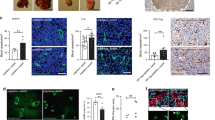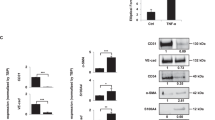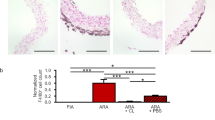Abstract
The microvasculature consists of endothelial cells and their surrounding pericytes. Few studies on the regulatory mechanisms of tumour angiogenesis have focused on pericytes. Here we report the identification of tumour-derived PDGFRβ+ (platelet-derived growth factor receptor β) progenitor perivascular cells (PPCs) that have the ability to differentiate into pericytes and regulate vessel stability and vascular survival in tumours. A subset of PDGFRβ+ PPCs is recruited from bone marrow to perivascular sites in tumours. Specific inhibition of PDGFRβ signalling eliminates PDGFRβ+ PPCs and mature pericytes around tumour vessels, leading to vascular hyperdilation and endothelial cell apoptosis in pancreatic islet tumours of transgenic Rip1Tag2 mice.
This is a preview of subscription content, access via your institution
Access options
Subscribe to this journal
Receive 12 print issues and online access
$209.00 per year
only $17.42 per issue
Buy this article
- Purchase on SpringerLink
- Instant access to full article PDF
Prices may be subject to local taxes which are calculated during checkout






Similar content being viewed by others
References
Sims, D. E. Diversity within pericytes. Clin. Exp. Pharmacol. Physiol. 27, 842–846 (2000).
Gerhardt, H. & Betsholtz, C. Endothelial-pericyte interactions in angiogenesis. Cell Tissue Res. 314, 15–23 (2003).
Cleaver, O. & Melton, D. A. Endothelial signaling during development. Nature Med. 9, 661–668 (2003).
Hirschi, K. K. & D'Amore, P. A. Pericytes in the microvasculature. Cardiovasc. Res. 32, 687–698 (1996).
Bergers, G. & Benjamin, L. E. Tumorigenesis and the angiogenic switch. Nature Rev. Cancer 3, 401–410 (2003).
Yancopoulos, G. D. et al. Vascular-specific growth factors and blood vessel formation. Nature 407, 242–248 (2000).
Betsholtz, C., Lindblom, P. & Gerhardt, H. Role of pericytes in vascular morphogenesis. EXS 94, 115–125 (2005).
Ozerdem, U. & Stallcup, W. B. Early contribution of pericytes to angiogenic sprouting and tube formation. Angiogenesis 6, 241–249 (2003).
Hirschi, K. K., Rohovsky, S. A. & D'Amore, P. A. PDGF, TGF-β, and heterotypic cell-cell interactions mediate endothelial cell-induced recruitment of 10T1/2 cells and their differentiation to a smooth muscle fate. J. Cell Biol. 141, 805–814 (1998).
Hellstrom, M., Kalen, M., Lindahl, P., Abramsson, A. & Betsholtz, C. Role of PDGF-B and PDGFR-β in recruitment of vascular smooth muscle cells and pericytes during embryonic blood vessel formation in the mouse. Development 126, 3047–3055 (1999).
Betsholtz, C., Karlsson, L. & Lindahl, P. Developmental roles of platelet-derived growth factors. Bioessays 23, 494–507 (2001).
Leveen, P. et al. Mice deficient for PDGF B show renal, cardiovascular, and hematological abnormalities. Genes Dev. 8, 1875–1887 (1994).
Lindahl, P., Johansson, B., Leveen, P. & Betsholtz, C. Pericyte loss and microaneurysm formation in PDGF-B-deficient mice. Science 126, 3047–3055 (1997).
Hellstrom, M. et al. Lack of pericytes leads to endothelial hyperplasia and abnormal vascular morphogenesis. J. Cell Biol. 153, 543–553 (2001).
Enge, M. et al. Endothelium-specific platelet-derived growth factor-B ablation mimics diabetic retinopathy. EMBO J. 21, 4307–4316 (2002).
Hirschi, K. K., Rohovsky, S. A., Beck, L. H., Smith, S. R. & D'Amore, P. A. Endothelial cells modulate the proliferation of mural cell precursors via platelet-derived growth factor-BB and heterotypic cell contact. Circ. Res. 84, 298–305 (1999).
Fukushi, J., Makagiansar, I. T. & Stallcup, W. B. NG2 proteoglycan promotes endothelial cell motility and angiogenesis via engagement of galectin-3 and α3β1 integrin. Mol. Biol. Cell 15, 3580–3590 (2004).
Benjamin, L., Hemo, I. & Keshet, E. A plasticity window for blood vessel remodelling is defined by pericyte coverage of the preformed endothelial network and is regulated by PDGF-B and VEGF. Development 125, 1591–1598 (1998).
Morikawa, S. et al. Abnormalities in pericytes on blood vessels and endothelial sprouts in tumors. Am. J. Pathol. 160, 985–1000 (2002).
Bergers, G., Song, S., Meyer-Morse, N., Bergsland, E. & Hanahan, D. Benefits of targeting both pericytes and endothelial cells in the tumor vasculature with kinase inhibitors. J. Clin. Invest. 111, 1287–1295 (2003).
Reinmuth, N. et al. Induction of VEGF in perivascular cells defines a potential paracrine mechanism for endothelial cell survival. Faseb. J. 15, 1239–1241 (2001).
Shaheen, R. M. et al. Tyrosine kinase inhibition of multiple angiogenic growth factor receptors improves survival in mice bearing colon cancer liver metastases by inhibition of endothelial cell survival mechanisms. Cancer Res. 61, 1464–1468 (2001).
Heldin, C. H. & Westermark, B. Mechanism of action and in vivo role of platelet-derived growth factor. Physiol. Rev. 79, 1283–1316 (1999).
Betsholtz, C. Insight into the physiological functions of PDGF through genetic studies in mice. Cytokine Growth Factor Rev. 15, 215–218 (2004).
Parangi, S. et al. Antiangiogenic therapy of transgenic mice impairs de novo tumor growth. Proc. Natl Acad. Sci. USA 93, 2002–2007 (1996).
Bergers, G., Hanahan, D. & Coussens, L. M. Angiogenesis and apoptosis are cellular parameters of neoplastic progression in transgenic mouse models of tumorigenesis. Int. J. Dev. Biol. 42, 995–1002 (1998).
Bondjers, C. et al. Transcription profiling of platelet-derived growth factor-B-deficient mouse embryos identifies RGS5 as a novel marker for pericytes and vascular smooth muscle cells. Am. J. Pathol. 162, 721–729 (2003).
Cho, H., Kozasa, T., Bondjers, C., Betsholtz, C. & Kehrl, J. H. Pericyte-specific expression of Rgs5: implications for PDGF and EDG receptor signaling during vascular maturation. Faseb. J. 17, 440–442 (2003).
Kanamori, M., Vanden Berg, S. R., Bergers, G., Berger, M. S. & Pieper, R. O. Integrin β3 overexpression suppresses tumor growth in a human model of gliomagenesis: implications for the role of β3 overexpression in glioblastoma multiforme. Cancer Res. 64, 2751–2758 (2004).
Nishishita, T. & Lin, P. C. Angiopoietin 1, PDGF-B, and TGF-β gene regulation in endothelial cell and smooth muscle cell interaction. J. Cell. Biochem. 91, 584–593 (2004).
Darland, D. C. & D'Amore, P. A. Cell-cell interactions in vascular development. Curr. Top. Dev. Biol. 52, 107–149 (2001).
Chen, S. & Lechleider, R. J. Transforming growth factor-β-induced differentiation of smooth muscle from a neural crest stem cell line. Circ. Res. 94, 1195–1202 (2004).
Rajantie, I. et al. Adult bone marrow-derived cells recruited during angiogenesis comprise precursors for periendothelial vascular mural cells. Blood 104, 2084–2086 (2004).
Ding, R., Darland, D. C., Parmacek, M. S. & D'Amore, P. A. Endothelial-mesenchymal interactions in vitro reveal molecular mechanisms of smooth muscle/pericyte differentiation. Stem Cells Dev. 13, 509–520 (2004).
Abramsson, A. et al. Analysis of mural cell recruitment to tumor vessels. Circulation 105, 112–117 (2002).
Lyden, D. et al. Impaired recruitment of bone-marrow-derived endothelial and hematopoietic precursor cells blocks tumor angiogenesis and growth. Nature Med. 7, 1194–1201 (2001).
Rabbany, S. Y., Heissig, B., Hattori, K. & Rafii, S. Molecular pathways regulating mobilization of marrow-derived stem cells for tissue revascularization. Trends Mol. Med. 9, 109–117 (2003).
Benjamin, L. E., Golijanin, D., Itin, A., Pode, D. & Keshet, E. Selective ablation of immature blood vessels in established human tumors follows vascular endothelial growth factor withdrawal [see comments]. J. Clin. Invest. 103, 159–165 (1999).
Pietras, K. & Hanahan, D. A multitargeted, metronomic, and maximum-tolerated dose “chemo-switch” regimen is antiangiogenic, producing objective responses and survival benefit in a mouse model of cancer. J. Clin. Oncol. 23, 939–952 (2004).
Ozerdem, U., Grako, K. A., Dahlin-Huppe, K., Monosov, E. & Stallcup, W. B. NG2 proteoglycan is expressed exclusively by mural cells during vascular morphogenesis. Dev. Dyn. 222, 218–227 (2001).
Naik, P., Karrim, J. & Hanahan, D. The rise and fall of apoptosis during multistage tumorigenesis: down-modulation contributes to progression from angiogenic progenitors. Genes Dev. 10, 2105–2116 (1996).
Ades, E. W. et al. HMEC-1: establishment of an immortalized human microvascular endothelial cell line. J. Invest. Dermatol. 99, 683–690 (1992).
Radvanyi, F., Christgau, S., Baekkeskov, S., Jolicoeur, C. & Hanahan, D. Pancreatic β cells cultured from individual preneoplastic foci in a multistage tumorigenesis pathway: a potentially general technique for isolating physiologically representative cell lines. Mol. Cell. Biol. 13, 4223–4232 (1993).
Acknowledgements
We thank N. Boudreau for valuable discussions and advice, D. Hanahan for RipTag2-Rag1ko/ko mice, N. Korets for excellent technical assistance, A. McMillan for statistical analysis, and S. Reynolds for help with the manuscript preparation. This work was supported by grants from the National Institutes of Health (R01 CA109390, R01 CA99948, RO1 CA95287, P01 CA72006), by an NIH Institutional NRSA fellowship to A.J.E. (5T32HL007731), by a grant from the American Cancer Society, and by start-up funds to G.B. from the Department of Neurological Surgery at UCSF.
Author information
Authors and Affiliations
Corresponding author
Ethics declarations
Competing interests
The authors declare no competing financial interests.
Supplementary information
Supplementary Information
Supplementary figures S1, S2 and S3 (PDF 544 kb)
Rights and permissions
About this article
Cite this article
Song, S., Ewald, A., Stallcup, W. et al. PDGFRβ+ perivascular progenitor cells in tumours regulate pericyte differentiation and vascular survival. Nat Cell Biol 7, 870–879 (2005). https://doi.org/10.1038/ncb1288
Received:
Accepted:
Published:
Issue Date:
DOI: https://doi.org/10.1038/ncb1288



